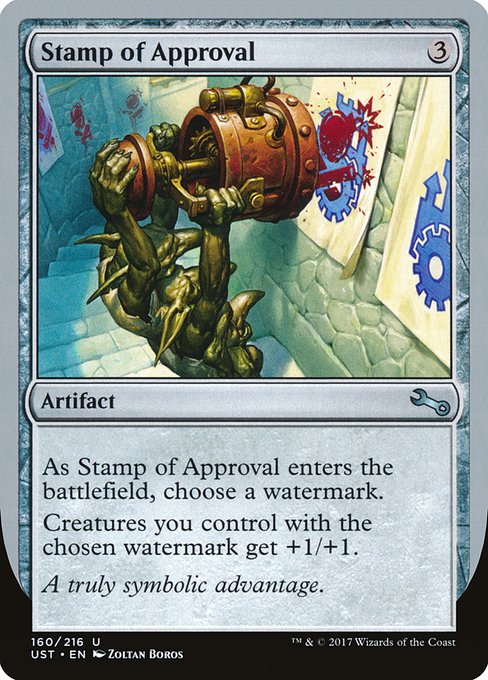
Image courtesy of Scryfall.com
Ethics, Speculation, and Stamp of Approval in MTG Finance
In the sprawling ecosystem of Magic: The Gathering, a card like Stamp of Approval invites us to examine what we actually value when we grow curious about prices and projections 🧙♂️🔥. Hailing from Unstable, the silver-bordered set famous for poking fun at game mechanics, this artifact costs 3 mana and reads: “As this artifact enters, choose a watermark. Creatures you control with the chosen watermark get +1/+1.” It’s not a powerhouse in a traditional sense, but it thrives on a clever design conceit—the moment you pick a watermark, you shape not just a board, but a narrative about identity and strategy ⚔️💎.
Stamp of Approval’s charm is twofold: first, its mechanical hook—the watermark choice—transforms a simple anthem into a memory of decision-making. Second, its placement in a joke set reminds us that value in MTG isn’t only about raw power; it’s about cultural resonance, artful humor, and the stories that players share when they gather around a table 🎨🎲. The card’s Unstable frame and flavor text, “A truly symbolic advantage,” lean into a playful, almost theatrical vibe. That vibe can influence the market in curious ways: collectors may chase foils for the novelty, while casual players enjoy the meme-driven appeal; yet speculative leaps should be tempered by a clear eye on playability and community impact 🧭.
Ethically, the heart of MTG finance rests on transparency, fairness, and the social contract of a hobby that’s deeply communal. Speculation—buying in the hopes that a card’s price will rise—can be a healthy form of market learning when it’s grounded in information, reasonable risk, and a willingness to share insights with others. It becomes problematic when price movements are driven by misinformation, fear, or attempts to squeeze newcomers out of a hobby they already love. Stamp of Approval, with its colorless identity and uncommon rarity, has a modest market footprint (nonfoil prices hovering in the single digits for many prints, foil a notch higher). Yet the psychology behind its price movement can illuminate broader dynamics: print history, meme culture, and the allure of novelty all intersect at the same crossroads where ethical questions about fairness and access live 🧠💎.
From a gameplay perspective, the watermark mechanic is a delightful reminder that MTG’s joy often comes from choosing a path and embracing the consequences. In casual Commander circles, a well-timed Stamp of Approval can create a satisfying tempo swing, rewarding players who anticipate synergies and board states rather than simply chasing the biggest number on the card text. It also offers a playful lens on market behavior: flashy, meme-driven cards can spike in popularity even if their in-game impact remains situational. When a card invites conversation about “which watermark matters most?” you’re witnessing a design that fuels both games and conversations—an essential component of a healthy, vibrant community 🪄🎲.
“The true value of a card isn’t just the dollars you can fetch, but the stories and experiments it enables at the table.”
For collectors and players alike, Stamp of Approval serves as a microcosm of MTG finance ethics. The card shows how a simple play on words—choosing a watermark—can ripple into deck-building decisions, trading discussions, and even the way people perceive value. It’s a gentle nudge to ask two questions: Do I buy this card for its future potential in casual play, or am I chasing a price trend that may fade as quickly as a meme? And are we fostering a welcoming environment for new players who want to join in on the fun rather than fend off speculation-based pressure? The community thrives when discourse stays grounded in playability, openness, and shared wonder about the multiverse 🌌💬.
Meanwhile, the broader ecosystem benefits from mindful consumption. If you’re researching MTG finance strategies, consider pairing theory with practice—save a few dollars for a foil or beautiful art piece, but don’t overlook why you’re drawn to a card in the first place. The design elegance of Stamp of Approval—and its Unstable context—offers a memorable example of how a card can be both a game piece and a cultural artifact. And as you brainstorm your next deck or collection, a little whimsy can go a long way toward keeping the game inviting and fun 🧙♂️✨.
To accompany your strategy sessions and price-tracking marathons, a stylish desk setup can be part of the experience. This neon cyberpunk desk mouse pad is customizable and one-sided, 3mm thick—perfect for late-night deck-building marathons or price-review marathons while you sip coffee and plot your next move 🔥🎨.
Neon Cyberpunk Desk Mouse Pad (Customizable, One-Sided Design, 3mm)Why watermark-minded design matters
Stamp of Approval’s entering-with-a-choice mechanic is a sly nod to the way MTG cards sometimes invite players to make a call—and live with the consequences of that call. Watermarks—though fictional here—mirror the real-world idea that there are many paths to victory, and sometimes the path you pick is as important as the result. In finance terms, it’s a study in option value and strategic belief: you invest in a board state that could scale with the right watermark, just as you invest in a card’s future price based on market signals and print history. The Unstable set’s playful frame makes this a teachable moment rather than a cautionary tale, reminding us to balance risk with wonder and humor 🧙♂️🎲.
Product details at a glance
- Set: Unstable (ust) • Type: Artifact • Rarity: Uncommon
- Mana Cost: 3
- Text: As this artifact enters, choose a watermark. Creatures you control with the chosen watermark get +1/+1.
- Art: Zoltan Boros • Flavor text: “A truly symbolic advantage.”
- Print: Foil and nonfoil versions exist; price varies by condition and print
More from our network
- https://crypto-acolytes.xyz/blog/post/solana-gaming-daos-redefining-ownership-and-playtime/
- https://blog.digital-vault.xyz/blog/post/frost-trickster-forcing-value-trades-in-commander/
- https://transparent-paper.shop/blog/post/high-converting-landing-page-templates-for-startups/
- https://crypto-acolytes.xyz/blog/post/the-artistry-behind-arcade-attraction-screens/
- https://transparent-paper.shop/blog/post/turn-templates-into-a-thriving-digital-business/